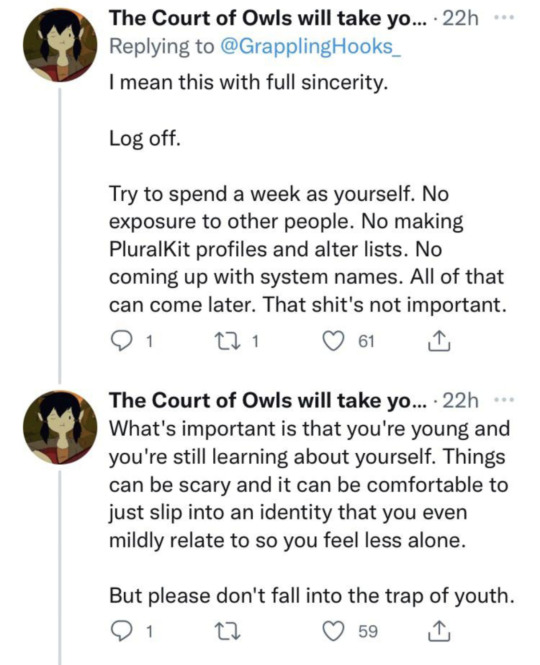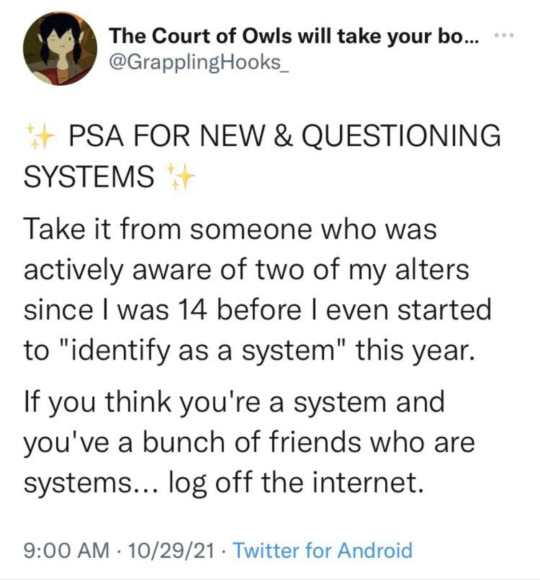Text
I saw this video on tiktok and I thought it was pretty interesting so I'm sharing it here. The source is linked.
66 notes
·
View notes
Text
Debunking Common DID Misconceptions
hi! this is my first really big post, and it’s a topic i’m excited to tackle. this post is, of course, dedicated to common misconceptions about DID, including some really absurd and silly ones i’ve seen online.
disclaimer: i’m an layman, not an expert. please keep this in mind when you read!
Separating Fact from Fiction: An Empirical Examination of Six Myths About Dissociative Identity Disorder (published 2016) is a great review of existing literature about DID, which dispels a number of pervasive myths that exist even in a clinical context. i’ve chosen to kick off this post by summarizing three points from this article which are commonly repeated by the average person - but please refer to the full article, because it’s very thorough, informative, and awesome.
Myth 1: DID is rare. this myth goes first, despite being third in the original article, because it is so incredibly pervasive among laypeople for absolutely no good reason (and it’s one even i myself have fallen for). i’ve seen quoted statistics as low as 0.01%, which is insanely off-base! the average prevalence rate is around 1.1%-1.5%, as reported in a study of a representative sample of 658 individuals from new york state. the DSM-V cites a very similar rate of prevalence overall (1.5% without accounting for gender), likely from the same study.

for perspective, estimated prevalence for BPD is 1.6%, and estimated prevalence of OCD is around 2%. DID is often perceived as “significantly rarer” than these disorders, or rare enough that one is unlikely to ever meet someone with DID, but the evidence hardly bears that out. this is also a dangerous myth for clinicians to buy into, as the belief that one will never encounter a DID patient and subsequent refusal to entertain the notion automatically sets those patients up for failure.
sometimes this runs the other direction, and DID is erroneously stated to be extremely common. higher rates are usually misquotes of studies of specific populations where the expected prevalence is naturally likely to be higher. for example, someone may read this study and believe the general prevalence rate for DID to be 6%, and quote it as such - but in reality, 6% is only the prevalence rate for an already highly traumatized population, and so naturally one would expect to find more DID patients in such a population due to its causation. this is also a mistake i see often, though moreso within the community of people who are diagnosed with or suspect themselves to have DID.
Myth 2: DID is overdiagnosed, and only by DID experts. many psych professionals diagnose DID without specifically specializing in its study or treatment. for example, in an australian study surveying 250 mental health clinicians, 52% had diagnosed DID in a patient before. in addition, DID is more likely to be underdiagnosed than overdiagnosed. studies of dissociative disorders tend to find that participants with DID are often not diagnosed prior to their evaluation in the study, and those with diagnoses are often untreated despite very high levels of functional impairment - in a study of german young adults and adolescents with dissociative disorders, only 16% had even sought treatment despite the severity of their deleterious symptoms.
even clinicians are frequently underinformed or undertrained where dissociative disorders are concerned. when a selection of US clinicians were asked to diagnose a patient based on a case vignette of a patient suffering the symptoms of DID, only around 60% correctly diagnosed DID - the most common misdiagnoses were PTSD, schizophrenia and depression, in descending order. a similar study from northern ireland found discipline also had an impact - when reviewing case vignettes psychologists were most competent, able to correctly identify DID 41% of the time, but psychiatrists correctly identified DID a paltry 7% of the time. unfortunately, skepticism as well as simple lack of training contribute to these poor outcomes for DID patients. people with DID and other dissociative disorders are a neglected demographic, not an inflated one.
Myth 3: DID is not real, and induced by therapists. this misconception is part of the fantasy model, also called the iatrogenic model, which posits that vulnerable, fantasy-prone patients are influenced by the media, their therapists, or other social influences to believe that they suffer from DID, thus in theory calling into question the disorder’s validity and the traumatic causation usually attributed to DID. there is no empirical evidence to support this model anywhere, in any study, and it has been directly challenged and undermined by a number of studies which find DID among participants in cultures where DID is not recognized; in addition, a number of studies have established a strong link between DID and childhood traumatization, which is accordingly the only accepted causation of the disorder. this myth, despite its pervasive influence even in clinical settings, has no basis in reality whatsoever, and is incredibly hurtful to those with dissociative disorders, which as previously discussed are a very vulnerable and neglected psychiatric population. unfortunately, this one is VERY pervasive, and repeated often, especially in the form of “DID is not real.”
Myth 4: DID cannot be diagnosed in any individual under 18. DID is a childhood trauma disorder, and therefore absolutely diagnosable in children. a number of factors are likely to make such a diagnosis difficult, such as ongoing abuse in the home posing obstacles, as well as the typical issues present in diagnosing dissociative disorders. however, there’s no rule against such a diagnosis, and in fact the ISST-D has released guidelines for the treatment of children and adolescents who are diagnosed with dissociative disorders.
the DSM-V also has a clause in the criteria for DID intended to assist in the proper diagnosis of children. should a child’s symptoms not be better explained by developmentally typical fantasy play, such as when the child’s reported behavior or self-reported identity disturbance is accompanied with amnesia, a diagnosis of DID is indeed possible.

[Image caption: Screenshot of PDF of the DSM-V, listing the diagnostic criteria for DID. A highlighted portion reads, “Note: In children, the symptoms are not better explained by imaginary playmates or other fantasy play.”]
Myth 5: DID doesn’t develop until the patient is at least 30. this one is, to be frank, completely stupid. given the disorder is diagnosable in children, professional guidelines exist for the treatment of said children, and it is a disorder associated with childhood traumatization, it is of course safe to say the disorder’s main features can easily develop in childhood. in addition, the DSM-V corroborates this further.

[Image caption: Screenshot of PDF of the DSM-V, in the Development and Course section for DID. A highlighted portion reads, “The full disorder may first manifest at almost any age (from earliest childhood to late life).”]
the basis of this myth is likely due to the usual age of diagnosis - statistically speaking, DID is typically diagnosed between the ages of 29 - 35, often 6 or more years after the first appearance of symptoms. however, the typical age of diagnosis doesn’t necessarily indicate the development and course of a disorder, and the claim that DID does not exist in individuals under 30 is demonstrably false.
Myth 5: Introjected identities such as fictional characters or real-life abusers, non-human alters, child alters, and other “strange” alters do not appear in legitimate DID cases. while the existence of all these parts may seem rather surprising or “out there,” the diversity of substitute beliefs in DID, which gives rise to many identity traits in alters, can be quite broad. many varieties of “strange” alters are documented in literature concerning DID; in the haunted self (not a link to the full text), often considered a seminal work on dissociative disorders and trauma, many such possible alters are listed:
In the literature on DID, various types of dissociative parts of the personality (that are not necessarily mutually exclusive) have been described (e.g., Boon & Van der Hart, 1995; Kluft, 1984, 1996a; Putnam, 1989; Ross, 1997). These include (1) host parts; (2) child parts; (3) protector and helper parts; (4) internal self helpers; (5) persecutor parts, based on introjects of perpetrators; (6) suicidal parts; (7) parts of the opposite sex; (8) promiscuous parts; (9) administrators and obsessive–compulsive parts; (10) substance abuse parts; (11) autistic and handicapped parts; (12) parts with special talents or skills; (13) anesthetic or analgesic parts; (14) imitators and imposters; (15) demons and spirits; (16) animals and objects such as trees; and (17) parts belonging to a different race. Some of these types of parts, such as child, persecutor, and suicidal parts are common, while others are not. All these parts can be regarded as more or less elaborated ANPs or EPs whose characteristics are defined by the action system(s) which mediate their functioning and which involve particular psychological defenses.
while certain “strange” parts may be relatively uncommon, none are impossible, and a wide variety of substitute beliefs can be observed in DID. the existence of strange substitute beliefs in an individual with DID does not negate the validity of their condition.
Myth 6: It is impossible or unusual for an individual with DID to have any awareness of alters. / Internal communication between alters is impossible. this is a very common belief, since it is partially grounded in the diagnostic criteria for DID. surprisingly, however, while amnesia is a diagnostic requirement and such amnesia may very well render the “host part” unaware, total ignorance of dissociated parts is not actually typical! the haunted self addresses this very issue.
Most often, the “host” has some recognition of other parts of the personality, although a degree of amnesia may be involved. However, occasionally, the “host” does not know about the existence of other dissociative parts of the personality, and loses time when others dominate executive control (Putnam, Guroff, Silberman, Barban, & Post, 1986). As C. R. Stern (1984) pointed out, it is more often the case that the “host” actively denies (active nonrealization) evidence of the existence of other dissociated parts of the personality rather than dissociative parts “hiding” themselves from the host. This nonrealization may be so severe that when presented with evidence of other dissociative parts, the host may “flee” from treatment.
additionally, “voices,” or intrusions from the patient’s dissociated parts of the personality, are considered a common aspect of the presentation of DID, as outlined by the DSM-V:
Individuals with dissociative identity disorder may report the feeling that they have suddenly become depersonalized observers of their “own” speech and actions, which they may feel powerless to stop (sense of self). Such individuals may also report perceptions of voices (e.g., a child’s voice; crying; the voice of a spiritual being). In some cases, voices are experienced as multiple, perplexing, independent thought streams over which the individual experiences no control.
these intrusions are mentioned again where differential diagnoses for psychosis are concerned:
Dissociative identity disorder may be confused with schizophrenia or other psychotic disorders. The personified, internally communicative inner voices of dissociative identity disorder, especially of a child (e.g., “I hear a little girl crying in a closet and an angry man yelling at her”), may be mistaken for psychotic hallucinations. Dissociative experiences of identity fragmentation or possession, and of perceived loss of control over thoughts, feelings, impulses, and acts, may be confused with signs of formal thought disorder, such as thought insertion or withdrawal. […] Persecutory and derogatory internal voices in dissociative identity disorder associated with depressive symptoms may be misdiagnosed as major depression with psychotic features.
Myth 7: It is possible to have DID without prior childhood traumatization. / Childhood traumatization is not the only cause of DID. while some without prior childhood traumatization may perceive themselves as having multiple self-states and compare such an experience with DID, it is outside the scope of this post to prove or disprove the validity of such an assertion, and this is not the focus of myth 7. such an experience is not and should not be confused for DID specifically. the only known cause of DID specifically is childhood traumatization; appropriately, the DSM-V only lists childhood traumatization as a risk factor.
Interpersonal physical and sexual abuse is associated with an increased risk of dissociative identity disorder. Prevalence of childhood abuse and neglect in the United States, Canada, and Europe among those with the disorder is about 90%. Other forms of traumatizing experiences, including childhood medical and surgical procedures, war, childhood prostitution, and terrorism, have been reported.
between interpersonal abuse and other traumatizing experiences, childhood traumatization accounts for 100% of DID cases, and a lack of recall does not constitute a lack of traumatization. such claims are, ultimately, not in keeping with the current scientific understanding of the disorder.
while it is commonly cited that the diagnostic criteria do not include prior traumatization and interpreted to mean that this implies an alternate causation, such an exclusion is intended to account for autobiographical amnesia in many DID patients; many will not recall the trauma responsible for their condition at the time of diagnosis.
furthermore, the central thesis of the haunted self is, to be incredibly simplistic, that such personality divisions as exist in DID are, in fact, due to the same posttraumatic mechanism as in PTSD, that being structural dissociation of the personality.
Dissociative parts are components of a single personality. Even parts that only encompass few experiences still have stable features. In this sense, all dissociative parts have their own “enduring pattern of perceiving, relating to, and thinking about the environment and self.” This is the DSM-IV criterion for dissociative identity or personality state (APA, 1994, p. 487), as well as the definition of personality traits (APA, 1994, p. 630). There is no qualitative principle in the current literature that distinguishes dissociative parts of the personality in DID from dissociative parts of the personality in other trauma-related disorders such as PTSD. We propose the difference is essentially one of degree of complexity and emancipation of the parts of the personality. [emphasis mine.]
while it is differentiated by its complexity in comparison to PTSD, DID is a trauma disorder that exists on the same “scale,” brought into being by the same mechanisms.
in conclusion, DID is often very misunderstood, and sometimes maligned or altogether dismissed. in reality, DID exists, and is a childhood trauma disorder with a number of complex characteristics, which can exist in an individual of any age. hopefully, understanding such misconceptions is helpful to you and any loved ones you may have with DID.
thank you very much for reading this post! i’ve been cautious with my sources, but if you’ve noticed any incorrect or badly summarized information here, please don’t hesitate to point it out - i am very open to making corrections.
436 notes
·
View notes
Text




A lot of people online follow a sort of "template" with DID, including making parts lists, using pluralkit or otherwise always having it known who's fronting, and being very openly a system all the time, among other things.
And this isn't wrong! But it's also far from the majority. Many people with DID, myself included, treat our DID differently. However, since the folks above are the ones most actively and openly posting online, it can feel like that's how everyone experiences DID. That was really overwhelming for me when I first got my diagnosis, because I didn't relate to the way a lot of people acted and thought.
My biggest advice for folks who either are diagnosed or are considering whether they have a dissociative disorder, or any other disorder really, is to take time for yourself first. Figure out independently what works best for you and your system. The internet will still be here. The community will still be here. Peer pressure isn't always a conscious thing. You can feel the pressure all by yourself.
3K notes
·
View notes
Text
Im immune to guilt trippy "hey reblog this, I see you ignoring this" posts. it could be the best take I've ever read in my life and then as soon as it finishes its statement with "everyone must reblog this" I black out and vaporize the post from my memory. what were you talking about? who knows who cares I'm looking at something else now
32K notes
·
View notes
Text





One of the things I've had to vontend with, growing up as a system, is he constant contradictions in self. How can I say I'm passionate about something, when half the time I'm super into it, and the other half I don't care at all about it.
[ID]
Panel 1: Person is showing Jak their phone, saying "Yeah it's a modern style, very boxy and sleek. It looks like a spaceship in my opinion. To which Jak just says "Mmhmn."
Panel 2: person is scrolling down and talking, "It's got TWO pools, van you believe it? Two pools, a jacuzzi, and this amazing garden encloses it all!" Jak is now thinking *OMG I don't care. Why is he showing me this?*
Panel 3: Person shows Jak the phone and says, "I know you like looking at architecture so I saved a couple of these places to show you." While Jak thinks, *Oh, he's trying to show Kyra."
Panel 4: person is scrolling through the phone while Jak, exasperated, thinks *Ugh, I hate not enjoying the hings I supposedly like.*
[END ID]
231 notes
·
View notes
Text
There's a few things I wish the DID subreddit would understand. This list is based on things I've actually seen asked on r/DID or r/AskDID.
This is a severe trauma disorder, meaning the brain is pulling out all of the stops to make sure it can cope with trauma. You won't find a "why" for everything.
Likewise, that's all DID is- dissociating from trauma and creating barriers with our underdeveloped sense of self. Alters cannot have powers, a completely separate brain, or other features that breach the simple "dissociated piece of the same brain" thing. They also can't "travel" from person to person. Thats a piece of your brain. It cannot walk out of your ear and into someone else's head.
However, psychosomatic symptoms are very common in systems. Anything to get away from the trauma. Another alter may very well experience digestive problems, chronic pain, or some other condition. Stress may also play a factor.
Introjected parts, especially fictional introjects, are more common in people who are neurodivergent. This is because of how we attach to media, especially when traumatised. It is not a sign of faking and we need to stop scrutinising introject-heavy system at every turn.
Yes you can have DID with only 2 parts. You can have a traumatised and emotional part as host. You can have a system purely of child parts. Your system tailors to your survival after the traumatic events.
Alters are dissociated pieces of the same brain with dreams, aspirations, likes, dislikes, fears, list goes on. Alters cannot be erased, killed, deleted, locked away or otherwise removed. Because you and that alter are ultimately separate identities in the same brain and had DID/OSDD not formed, you would be the exact same person. People who tell you that you can kill, erase, remove, lock away or otherwise dispose of an alter are not only telling you misinformation, they are insinuating that you need to repress or ignore a part of yourself. That's disingenuous and extremely harmful. So please stop asking how to k*ll the host, r/DID.
The inner world is a visualisation tool. People without DID have an inner world. Things that happen in the inner world are pure visualisation. An alter who presents as pregnant in the inner world doesn't mean the body itself is pregnant. Those two things aren't connected. Injury in the inner world does not mean the body itself is injured. Keep in mind that it's purely a visualisation tool and you very well might not have one.
You ultimately cannot tell if someone does or doesn't have DID. It's covert and you can't get inside their brain.
DID/OSDD is built on denial and is not indicative on if you do or don't have the disorder.
You don’t have to tell everyone everything about your system purely because someone asked. I mean go ahead if you’d like but do know that giving away information about alters can be a very telling sign of your experiences which can be used for or against you.
Might be more to come as I read over that place.
129 notes
·
View notes
Text
good post, but "simply" nothin, completing a pokedex without cheating is just as impressive as writing a novel lmao
(this is a joke)
(but also kind of not)
whether you’re project is writing a novel in a month or simply completing the pokédex, it’s valid. you’re accomplishing something you want to do and i’m proud of you for it
1K notes
·
View notes
Text
Does anyone have any tips to tell if an alter is age sliding verses age regressing? Is there really a difference when alters are involved?
One of our alters recently came out of dormancy and we were assuming he's age sliding, but I'm not really sure... And he certainly doesn't know.
Any tips or experiences on the matter would be super helpful! I just want to be able to help him feel comfortable the best I can~
- Rosie
1 note
·
View note
Text
oh, and villainizing/attacking systems for wanting to keep their spaces traumagenic is fucking shitty.
a lot of systems i've seen on blocklists or being smeared in the tags aren't using endo tags or even posting syscource at all, and yet they're still being painted as bad people. that's so fucking shitty, c'mon. have some common sense and decency.
endos and traumagenics really just need to leave each other the fuck alone, nothing good is coming from all this conflict. all it's doing is triggering people and making all our mental health worse than it already fucking is.
hot take: creating a space tailored to traumagenic systems and not wanting endos to interact for that reason is not anti-endo and doesnt make the poster “sysmed”
existing as a traumagenic system and talking about our experiences exclusively is not anti-endo
22 notes
·
View notes
Text
hot take: creating a space tailored to traumagenic systems and not wanting endos to interact for that reason is not anti-endo and doesnt make the poster "sysmed"
existing as a traumagenic system and talking about our experiences exclusively is not anti-endo
#don't get me wrong - going into endo tags and attacking/fakeclaiming is NOT okay#but#there are plenty of blogs that just want to interact with traumagenic systems only bc they share experiences#idgaf about endos but my posts are by a traumagenic for traumagenics#did#osdd#dissociative identity disorder#other specified dissociative disorder#about#🍀
22 notes
·
View notes
Text
fun game
represent your alters as pictures u already have on your phone
feel free to add your own (endos dni)
lucky:

andrew:


(andrew gets two bc that's just How He Is)
rosie:

yuri:

eren:

katsuki:

#part 1?? perhaps????#did#osdd#other specified dissociative disorder#dissociative identity disorder#about#🍀
9 notes
·
View notes
Text
ohooo boy PLEASE stop posting your/your system’s triggers online, it is not fucking safe
it’s one thing to mention certain triggers to people you know so that they won’t be brought up accidentally, but don’t just fucking stick them on your profile. great way to get trolls to trigger you for fun, or for people to pull you/other alters to the front without your permission.
don’t give random people on the internet that kind of power over you, for fuckssake
bc apparently people can't read goddamn DNIs: ENDOS DNI. THIS POST ISNT FOR YOU
64 notes
·
View notes
Text
i think you kind of answered your own question on this one; if you're trying to work with a certain alter and their source or pseudo-memories are relevant, then she needs to know the parts that that are relevant to understand where the alter is coming from.
i personally don't even think it's necessary to talk about that part specifically as an introject, though it can provide some context. pseudo-memories are pseudo-memories, whether they're from an outside source or not.
i've explained it sort of like: "this alter has memories of [x, y, and z] that affect them, though i haven't experienced these things myself," and provide as much context as necessary to work towards your goals with that part. if their source as a whole is relevant, then discuss that. if not, then perhaps just mention they're an introject and then focus on the pseudo-memories themselves.
anyway, this is just my two cents. i'm in no way an expert on literally anything, so take it with a grain of salt.
okay genuine question, how much about a piece of media does my therapist actually need to know if i have introjects from that media? like what details are important for her to know and understand why this alter(s) feel the way they do? especially if the media has things that cause trauma that these alters have latched on to that are superficially different from what i experienced?
6 notes
·
View notes
Text
something i find really difficult as the host of a system is explaining to people like...me being the host doesn’t make me “above” or “not part of” the system. it’s just my role, like all of our alters have. i may feel the most connected to this body and the outside world, but that doesn’t mean this is my body or my life, and the rest of us are just there to serve me. i’m not a person with a system, i am part of a system. it’s my system, AND my parts’ system. it’s us, a collective entity.
this is why i prefer to say “i’m a part of a DID system” rather than “i have DID” when I can; it feels more correct to my experience. i don’t feel that, like...i was “the original” just because i happen to be the host currently and front the most. we never had a solid identity to start with. that’s why, as far as my research can tell, initial development of DID/OSDD happens in childhood; it takes years for a child’s mind and personality to settle into a solid identity and sense of self, and trauma can fracture the tenuous connections that start to form throughout childhood. (this may be an incorrect way of looking at it, i’m certainly not an expert, but i believe that’s an accepted theory these days.)
anyway, i guess i’m trying to say that explaining this to people, especially people who aren’t part of a system, is real damn hard. as is explaining most things about being a system lol
- lucky
5 notes
·
View notes
Text
I love how the “research” endos post only ends up showing how little research they’ve actually done. Do you read the “research” you post? If you have, you must realize that it isn’t reliable because it’s not done by experts in the field who spend lots of time over multiple sessions to learn about the patients, analyze their life from an outside perspective, and study similarities between cases to then form psychological evidence(Even brain scans!).
These “studies” are done by people conducting simple online forms that people can fill out. They don’t actually have any context, reasoning, comorbidities, possible differential diagnosis’s, or even know the patient they are doing research on in the slightest.
You realize you get a diagnosis by a professional because they can learn about your life, ask the right questions, and make a diagnosis from an outside, unbiased perspective of yourself? DID/OSDD involves amnesia, which can make it virtually impossible for people to know they are plural, their symptoms, or trauma because you simply don’t remember what you don’t remember. This is why a professional, who can spend time with more than just 1 alter and won’t experience the amnesia barriers that keep those things hidden from you, makes a diagnosis.
You guys act as if making a basic survey for randos is enough to prove anything without psychological evidence from professionals in the field, and it’s absolutely not. Do you even read your own sources? Do you know how to tell if a source has any validity in psychopathology?
If you’re going to post sources trying to prove your point, at least read it and realize it doesn’t help your case before you deceive people who would otherwise just believe what you are saying. Stop acting as if your made up terms for appropriating mental illness has any psychological evidence to back it up, because it doesn’t and you’re proving that yourself.
✨read your sources before you use them to prove yourself wrong✨
120 notes
·
View notes
Text
psa for people about to go in the DID tag and make sweeping generalizations about how systems should feel/act/whatever:
maybe don't do that, its fucking annoying and a misrepresentation of systems.
every system experiences things differently. sure, there are some tie ins that will always be there (like that systems are formed from trauma), but DID is so fucking changeable and unpredictable even within a system, so trying to generalize between systems just ends up making you look like an asshole, especially if you're trying to use those claims to gatekeep.
make as many posts as you want about YOUR OWN experience as a system, but stop trying to speak for all systems.
but hey, if you really have to make that kind of post, don't get pissy when someone corrects you.
- andrew
p.s. endos dn fuckin i
10 notes
·
View notes
